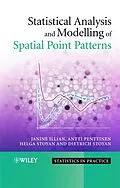Spatial point processes are mathematical models used to describe
and analyse the geometrical structure of patterns formed by objects
that are irregularly or randomly distributed in one-, two- or
three-dimensional space. Examples include locations of trees in a
forest, blood particles on a glass plate, galaxies in the universe,
and particle centres in samples of material.
Numerous aspects of the nature of a specific spatial point
pattern may be described using the appropriate statistical methods.
Statistical Analysis and Modelling of Spatial Point Patterns
provides a practical guide to the use of these specialised methods.
The application-oriented approach helps demonstrate the benefits of
this increasingly popular branch of statistics to a broad
audience.
The book:
* Provides an introduction to spatial point patterns for
researchers across numerous areas of application
* Adopts an extremely accessible style, allowing the
non-statistician complete understanding
* Describes the process of extracting knowledge from the data,
emphasising the marked point process
* Demonstrates the analysis of complex datasets, using applied
examples from areas including biology, forestry, and materials
science
* Features a supplementary website containing example
datasets.
Statistical Analysis and Modelling of Spatial Point
Patterns is ideally suited for researchers in the many areas of
application, including environmental statistics, ecology, physics,
materials science, geostatistics, and biology. It is also suitable
for students of statistics, mathematics, computer science, biology
and geoinformatics.
Autorentext
Janine Illian, SIMBIOS, University of Abertay, Dundee, Scotland.
Antti Pentinen, Professor in the Department of Mathematics and Statistics, University of Jyvaskyla, Finland.
Dietrich Stoyan, Professor a the Insitut für Stochastik, University of Freiberg, Germany.
Klappentext
Spatial point processes are mathematical models used to describe and analyse the geometrical structure of patterns formed by objects that are irregularly or randomly distributed in one-, two- or three-dimensional space. Examples include locations of trees in a forest, blood particles on a glass plate, galaxies in the universe, and particle centres in samples of material.
Numerous aspects of the nature of a specific spatial point pattern may be described using the appropriate statistical methods. Statistical Analysis and Modelling of Spatial Point Patterns provides a practical guide to the use of these specialised methods. The application-oriented approach helps demonstrate the benefits of this increasingly popular branch of statistics to a broad audience.
The book:
- Provides an introduction to spatial point patterns for researchers across numerous areas of application.
- Adopts an extremely accessible style, allowing the non-statistician complete understanding.
- Describes the process of extracting knowledge from the data, emphasising the marked point process.
- Demonstrates the analysis of complex datasets, using applied examples from areas including biology, forestry, and materials science.
- Features a supplementary website containing example datasets.
Statistical Analysis and Modelling of Spatial Point Patterns is ideally suited for researchers in the many areas of application, including environmental statistics, ecology, physics, materials science, geostatistics, and biology. It is also suitable for students of statistics, mathematics, computer science, biology and geoinformatics.
Companion website:
www.wiley.com/go/penttinen
Inhalt
Preface.
List of Examples.
1. Introduction.
1.1 Point process statistics.
1.2 Examples of point process data.
1.2.1 A pattern of amacrine cells.
1.2.2 Gold particles.
1.2.3 A pattern of Western Australian plants.
1.2.4 Waterstriders.
1.2.5 A sample of concrete.
1.3 Historical notes.
1.3.1 Determination of number of trees in a forest.
1.3.2 Number of blood particles in a sample.
1.3.3 Patterns of points in plant communities.
1.3.4 Formulating the power law for the pair correlation function for galaxies.
1.4 Sampling and data collection.
1.4.1 General remarks.
1.4.2 Choosing an appropriate study area.
1.4.3 Data collection.
1.5 Fundamentals of the theory of point processes.
1.6 Stationarity and isotropy.
1.6.1 Model approach and design approach.
1.6.2 Finite and infinite point processes.
1.6.3 Stationarity and isotropy.
1.6.4 Ergodicity.
1.7 Summary characteristics for point processes.
1.7.1 Numerical summary characteristics.
1.7.2 Functional summary characteristics.
1.8 Secondary structures of point processes.
1.8.1 Introduction.
1.8.2 Random sets.
1.8.3 Random fields.
1.8.4 Tessellations.
1.8.5 Neighbour networks or graphs.
1.9 Simulation of point processes.
2. The Homogeneous Poisson point process.
2.1 Introduction.
2.2 The binomial point process.
2.2.1 Introduction.
2.2.2 Basic properties.
2.2.3 The periodic binomial process.
2.2.4 Simulation of the binomial process.
2.3 The homogeneous Poisson point process.
2.3.1 Introduction.
2.3.2 Basic properties.
2.3.3 Characterisations of the homogeneous Poisson process.
2.4 Simulation of a homogeneous Poisson process.
2.5 Model characteristics.
2.5.1 Moments and moment measures.
2.5.2 The Palm distribution of a homogeneous Poisson process.
2.5.3 Summary characteristics of the homogeneous Poisson process.
2.6 Estimating the intensity.
2.7 Testing complete spatial randomness.
2.7.1 Introduction.
2.7.2 Quadrat counts.
2.7.3 Distance methods.
2.7.4 The J-test.
2.7.5 Two index-based tests.
2.7.6 Discrepancy tests.
2.7.7 The L-test.
2.7.8 Other tests and recommendations.
3. Finite point processes.
3.1 Introduction.
3.2 Distributions of numbers of points.
3.2.1 The binomial distribution.
3.2.2 The Poisson distribution.
3.2.3 Compound distributions.
3.2.4 Generalised distributions.
3.3 Intensity functions and their estimation.
3.3.1 Parametric statistics for the intensity function.
3.3.2 Non-parametric estimation of the intensity function.
3.3.3 Estimating the point density distribution function.
3.4 Inhomogeneous Poisson process and finite Cox process.
3.4.1 The inhomogeneous Poisson process.
3.4.2 The finite Cox process.
3.5 Summary characteristics for finite point processes.
3.5.1 Nearest-neighbour distances.
3.5.2 Dilation function.
3.5.3 Graph-theoretic statistics.
3.5.4 Second-order characteristics.
3.6 Finite Gibbs processes.
3.6.1 Introduction.
3.6.2 Gibbs processes with fixed number of points.
3.6.3 Gibbs processes with a random number of points.
3.6.4 Second-order summary characteristics of finite Gibbs processes.
3.6.5 Further discussion.
3.6.6 Statistical inference for finite Gibbs processes.
4. Stationary point processes.
4.1 Basic definitions and notation.
4.2 Summary characteristics for stationary point processes.
4.2.1 Introduction.
4.2.2 Edge-correction methods.
4.2.3 The intensity .
4.2.4 Indices as summary characteristics.
4.2.5 Empty-space statistics and other morpho…
